D6
Magic
Guestbook
Magic in the world of the Evil Dead is dark, dangerous and only rarely
wielded by human hands. It consists of ritualistic spells and complex
alchemical potions. On occasion, characters may find magical items
that provide wondrous abilities or cause nightmarish harm.
Ritualistic Magic
Ritualistic magic involves nearly all spells that are cast from reading a scroll or book, or reciting memorized words while inside a specially prepared area (such as a circle of power, a pentagram, a blessed tabernacle, etc.). They usually require three main elements: 1) A magical text; 2) Symbols and/or magical reagents; and 3) Recital of an incantation. Because magic rituals exist for nearly any kind of spell, these rules focus on the process of researching and casting a ritual rather than specific spells which may be cast. GM's should provide opportunities for spell-casting as the plot requires, not, generally, as players desire.
Reading Dusty Old Books
A character must first research the spell to be cast. This usually
begins with an inquiry or statement from the player as to what the desired
effect will be. The GM will then decide the difficulty of the research--depending
on the obscurity and age of the spell, the power of the intended result,
and means of research available to the character. Then, the character
will roll a Hocus-Pocus check against the Difficulty. If successful,
the character will find the necessary texts and a list of needed materials.
Example: Romanov, a Creepy Old Guy (COG?) who sometimes advises Vern on how to best battle the deadites, finds out that the Black Book of Agrippina has a spell that will banish the local deadites back to Hell, at least temporarily. He must research where the Black Book can be found and the magic words required to cast the spell. The GM decides that the Black Book is pretty well known, so it will only be a Moderate Hocus-Pocus check for Romanov to find out the necessary information.Gather the Goods
Once the character has researched the problem, he must still acquire the necessary materials. This may require additional research, investigation, bargaining, theft, or manufacturing time.
Example: Romanov manages locate a copy of the Black Book now in the library of a local occultist (what luck!). He tells Vern that he must secure the book at all costs and that the deadites are probably closing in on the Book by the moment. Vern loads up his Pinto with a couple of friends and lots of ammo, and rushes on over to "borrow" the book.Say the Magic Words
Once the materials are gathered, they must be properly put into place and the magic words must be incanted properly. If the text is in an Ancient Language, the GM will have the character make a Language: Ancient check. Then, the character must make an Hocus-Pocus check. Again, the GM adjusts the difficulty for the degree of preparation, the complexity of the spell, and potency of the outcome. If the check is successful, the spell will be cast and the desired effect will manifest (hopefully).
Example: The GM tells Vern that the Black Book is written in Latin, so Vern will have to make a Languages: Ancient check of Moderate to even read the spell. The GM sets the casting Difficulty at Moderate (15) and Vern will use his Hocus-Pocus skill to attempt the ritual. Vern's Hocus-Pocus is only 3D, and his roll is only a 12! Vern fails to open the vortex and can hear the shuffling feet of zombies getting closer and closer...It is also possible for someone to tell the caster EXACTLY what to say when holding the magic book or implement in order to cast the spell. The GM should tell the character what to say and then have him repeat it when it's time for the spell to be cast. If the player cannot repeat it, the spell will fail. If a character is reciting magical words from memory, increase the casting Difficulty (the Hocus-Pocus roll) by 5.
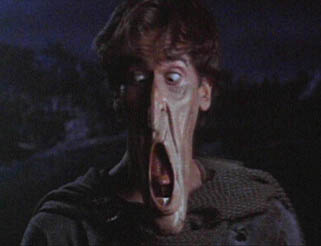
Botching the Casting
Given their complexity, spells are easy to mess up. And when you mess up with magic, you usually mess up bad. When a casting fails, it will either have no effect at all (it just sort of fizzles out) or it will go wrong in some unpredictable and unpleasant way. Generally, the worse the failure, the more grave the consequences. If a character Botches (rolls a 1 on the Wild Die, followed by a 6 on the subsequent roll), then something spectacularly wrong has occurred. The demon villain will be strengthen, the hero will be turned into a toad, you'll open a rift to some hell-dimension full of hungry, drooling dog-men. You get the picture. So be careful kids.
The Costs of Casting
All magic has a cost associated with it. Sometimes, the spell
will be so trivial that the caster will not notice the loss. But
when a major spell is attempted, the character will exhaust herself with
the effort. Whenever a spell is attempted, the caster (or casters)
must make a Tough Guy check against the Difficulty of the spell.
She will suffer exhaustion as if it were Wound Levels if her roll is less
than the Difficulty number (i.e., as if the Difficulty Level value were
damage and the Tough Guy roll were a Body check). No actual damage
will be done, but the character will suffer the appropriate penalties to
all her actions until she rests (1/2 hour per "Wound" Level). If
she reaches Incapacitated or Mortally Wounded, she will pass out for a
brief period (1/2-1 hour). If she suffers enough "damage" to be "Dead",
she will fall into a coma and require medical assistance.
THE RELIQUARY
It is quite likely that characters will come into contact with magical items and implements during their struggle against the deadites. Most often, these arcane items will look like dusty old books or gold-plated museum-pieces. But, with the proper knowledge, a character may make use of the items to stave off the deadite invasion.
Design note: People with any real knowledge in this area will quickly find that while I have used the name of some real books and items, I have conveniently abused all other relevant data such as authorship, publication date, language and contents. In my meager defense, this is all to add content to the game, not provide a historical reference for occult items. There are smarter, more reliable folks you should be looking to for that sort of thing.
Grimoires
Since man first began writing, he scribed treatises on the wonders
of the known and unknown world. From cave paintings, Egyptian hieroglyphics,
to internet sites, spells and arcane knowledge remains contained in the
written word. Below is a list of some of the more famous magical
texts players may encounter. This list is intended to help GM's structure
their campaigns. Often, an entire campaign may focus on acquiring
and using just one of these texts. See my Links
section for some other websites that discuss magical texts with varied
seriousness.
The Necromonicon ("Al Azif")
Author: Abdul Alhazred (The "Mad Arab")
Language: Ancient Arabic and the secret language of Cthulu.
Translations have been made into Ancient Greek, Ancient Latin, Old Spanish,
and, perhaps, modern English.
Est. Publ.: 720 AD.
Availability: Extremely Rare. Perhaps only one "true"
copy exists today. Tragedy tends to befall any man who holds the
book too long.
Contents: Demonology; Exorcisms of demons, Spells to raise
and control the dead and other deadites; Rituals to open time-space portals.
Powers: Can be used to exorcise demons, raise a deadite
army (even by accident!), and open space-time portals. Likely many
other powers.
The Necromonicon has some kind of life of
its own, infused with all of Alhazred's evil knowledge. It can fly
(like a bat!) and attack for 3D damage. It likely has other attacks
and defenses.
History: Abdul Alhazred traveled extensively throughout
the Persian and northern African territories, visiting many ancient ruins
and encountering untold horrors, demons and magi. Towards the end
of his life, he settled for a short time in Damascus, where he penned his
masterwork, the Necromonicon, pouring it into all his metaphysical
knowledge and, some would say, his soul. Shortly thereafter, as retribution
for revealing so many otherworldly secrets, Alhazred was attacked in broad
daylight and devoured by a demon in front of numerous witnesses.
Written in human blood and bound with human
skin, the Necromonicon is believed by many to be the single most
powerful grimoire in existence today. The user can raise, control
and destroy whole deadite hordes with but a few words, travel across space
and time, and call upon the darkest demonic powers. However, any
holder should beware: his actions will become twisted for the purposes
of Evil over time.

The Key of Solomon
Author: King Solomon (the one in the Bible).
Language: Ancient Hebrew (Semitic).
Est. Publ.: 1000 BC. Reprinted and translated numerous
times.
Availability: Extremely Rare (1-3 copies known to exist
today, and these may all be fraudulent).
Contents: Demonology, Secret Names of God and Lucifer,
Prayers, Charms and Blessings.
Powers: Can be used to exorcise demons, call upon the
aid of angelic powers, heal wounds, bless weapons, and shield from demonic
attacks.
History: The original "Key" was actually a series of scrolls,
said to be kept in a sacred ark--not unlike that which contains the 10
Commandments--which was lost during Roman occupation of the Hebrews' lands.
Modern copies are said to derive from a single copy made by Solomon's scribe
and given to an ally king to the east (in what is now Iran). The
"Second Key" was last reported during the 3rd century, supposedly in Mecca,
where another copy was made and smuggled to Rome (supposedly by the Angel
Azrael). That "Third Key" was copied centuries later and sent to
various libraries throughout Europe. Most of these copies have been
lost. No one knows if any of the Three Keys exist today.
Shalshelet he-Kabbala
Author: Gedaliah ibu Yahya
Language: Modern Hebrew
Est. Publ.: 1697.
Availability: Extremely Rare (3-5 copies).
Contents: Comprehensive treatise on the secrets of the
Kabbala, alchemical recipes from potions and artifacts, secret codes and
mathematics.
Powers: Mainly known for providing insight into other
magical texts and artifacts (breaking the magical codes of their inscriptions).
Also has a variety of recipes for making magical potions, including some
that can cure the deadite infection.
History: The premier work of the Middle Eastern Kabbalists,
the Shalshelet he-Kabbala is well known but only rarely seen.
To date, no one has been able to verify the veracity of the known copies.
Some rumors say that the real Shalshelet could not be viewed by
human eyes, as its coded words were too complex and would drive a man mad.
They say that the original book is actually kept in an underground crypt
below modern Jerusalem, guarded by unsleeping Kabbalistic golems (stone
warriors).
Enchiridion of Pope Leo III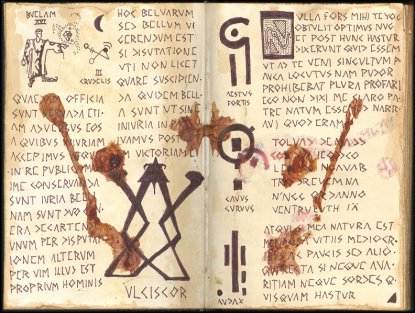
Author: Emperor Charlemagne (given as a gift to Pope Leo)
Language: Ancient Latin
Est. Publ.: 4th Century AD
Availability: Unique (1 copy, kept at the Vatican).
Contents: Prayers, charms and other invocations for requesting
heavenly blessings and protections. Also includes numerous passages
on demonology, especially demons worshipped in the Mediterranean.
Powers: Proper prayers may repel deadite attackers and
even disintegrate them on the spot. Some of the charms may be used
to enchant items and potions to battle the soulless.
History: As Charlemagne adopted Christianity as the religion
of Rome, he made a gift of the Enchiridion--the most comprehensive
Roman treatise on the demons and magicks of the Mediterranean. It
was a symbol of entrusting Rome's spiritual protection to the newly accepted
Church. The Enchiridion itself was one of the first major
pieces of the Vatican library--which probably has more books on the occult
than any library still standing today. Some scholars assert that
the book has many secret codes and passages that have not been made known
to the public, including ways to bridge the gap between the dimensions
of Hell and Earth, and the true names of many ancient demons. The
Enchiridion
is bound in heavy gold covers and kept locked with in intricate mechanism
(rumored to be magic in itself).
Heptamaron
Author: Peter de Abano
Language: Latin
Est. Publ.: 15th Century.
Availability: Uncommon (numerous copies in existence,
but each copy may not be complete).
Contents: Primarily a roster of known angels, demons and
other spiritual powers, listing their preferences, abilities, weakness
and mode of communication.
Powers: Can be used to research the weaknesses of a supernatural
being or to attempt to contact one.
History: Burned at the stake as a heretic and a witch,
Peter of Abano lived for a short time as Europe's premier expert on demonology,
angelogy, and invocation of supernatural powers. Legend has it that
he was called before the Pope and ordered to demonstrate his abilities.
De Abano complied, calling forth the Seraphim angel Mahil, who quickly
recognized the Pope's corruption and strode forward to deliver justice.
The Pope commanded de Abano to banish the angel. The terrified scholar
once again obeyed, saving the Pope's life (but not his soul). In
his gratitude, the Pope declared de Abano a witch and sent him to the pyre.
Grand Grimoire
Author: unknown
Language: Latin
Est. Publ.: Est. 12-15th century
Availability: Uncommon.
Contents: An attempted "encyclopedia" of the supernatural,
with information on demons, angels, alchemy, spells, prayers, artifacts
and astrology.
Powers: Primarily a research tool, though it does include
numerous spells which may have relatively limited, temporary effects.
History: The Grand Grimoire is one of the most
famous of the medieval texts on the occult. Written over the course
of three centuries, managed by numerous editors, and constantly threatened
with destruction by both earthly and supernatural forces, the Grimoire
remains one of the most comprehensive treatises on the Western occult tradition
today.
Magus
Author: Barrett
Language: Latin
Est. Publ.: 16th Century.
Availability: Very rare.
Contents: Demonology (demon names, ranks, powers, weaknesses
and invocation rites).
Powers: Can be used to research the weaknesses of a demon
or to attempt to contact one.
History: Considered a relatively minor work until recently,
Barrett's Magus attempted to list and categorize all the known demons
of Hell. Some say that he had to bribe demons by selling bits of
his own soul in order to learn of the secret workings of the infernal orders.
Only in recent times, with the increase in demon activity, has the Magus
become a work of interest to occultist. Very few copies exist, and
some say all but one or two are frauds.
Cosmographia Universalis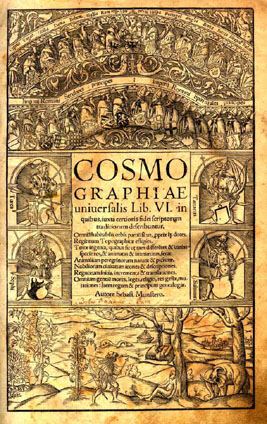
Author: Buel
Language: Latin
Est. Publ.: 1544.
Availability: Rare (7-10 copies in existence).
Contents: An attempted "physics" book of the metaphysical
world. Attempts to explain how to control supernatural powers, create
rifts between various dimensions, and overcome limitations of our physical
realm.
Powers: Provides science-like methods for creating space-time
rifts, recommends alchemical solutions to channel supernatural powers (creation
of magical crystals and machines, etc.).
History: Even other occultists of the day thought that
Buel was deluded when he began, at age 16, his dissertation on the physical
qualities of the supernatural world. Buel sacrificed his entire life
to the effort: squandering his family's vast fortune on experiments,
reagents and other texts; foregoing the opportunity to marry a willing
marquise; finally going blind and half-mad in his hermitage, reciting the
last few lines of his work to an ancient parrot who miraculous remembered
the words and recited them to scholars when questioned. Buel's young
nephew collected the scholar's papers and managed to bind them together
into publishable form. The collected works sat in the library of
the Abbe Montain until the late 17th century, when they were published
in limited form more because of the beauty of Buel's illustrations than
the content of his words.
Die Kunst Ciromantia
Author: unknown.
Language: Old German.
Est. Publ.: 16th Century.
Availability: Rare.
Contents: Spells, charms, and invocations based on chiromancy.
Powers: Provides some general attack and protection magicks.
Is more specific to battling demons associated with northern Europe and
western Asia.
History: The "textbook" of chiromancy is more than mere
guide the ways of Germanic witches in the 16th century. It provides
relatively easy-to-follow instructions for casting a variety of spells
(from trivial "love spells" to more dangerous "charms" that provide protection
against evil spirits).
Artifacts
Characters will likely come into contact with magical weapons, rings
and other devices during their battles against the undead. These
items often provide certain powers to the bearer, but the weight of those
new abilities typically burden even the purest soul after extended use.
For those reasons, mortals rarely retain a magical item for more than a
short period of time--usually as long as the item "lets" itself be used.
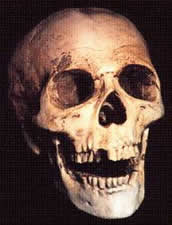 Skull
of Jacques de Molay
Skull
of Jacques de Molay
Description: Human skull, blackened from the pyre.
Est. Creation: 13th Century.
Powers: Complete power unknown. Is believed to greatly
enhance the invocation of spirits and provide protection and control over
those spirits once invoked. Some believe it can be used to actually
control the undead. Finally, it is said that the Skull will speak
when questioned, providing arcane secrets.
History: Jacques de Molay was the last Grand Master of
the Knights Templar, one of the most famous orders of knights to serve
the medieval Church. When the Templars became too powerful and political,
Molay, like many of his brothers, was branded a heretic and burned at the
stake. His Skull, ordered by the Pope to be smashed, was smuggled out of
France and kept in Northern African until the 17th century, when a British
explorer and occultist found the skull along with many of de Molay's belongings
in a small trunk up for sale in a Moroccan market. The explorer purchased
the trunk, wrote to a colleague at Oxford regarding the find and asked
his friend to come meet him in Morocco. When the friend arrived,
there was no trace of either the explorer, or de Molay's trunk...

The Tetragrammaton
Description: Simple-looking British longsword with the
word " Tetragrammaton" inscribed on both sides.
Est. Creation: 11th century
Powers: Does 3 x damage to undead and demonic targets.
Gives the bearer +3D to Stabbing, Slashing and Bludgeoning rolls,
+2D to Getting Out of the Way, +2D to Body to avoid damage, and
+2D to any Jock Skills. If a possessed person is struck by
the sword (even if not wounded), any spirit possessing the victim will
be forced from the body.
History: During a deadite invasion of the British Isles
in the 11th century, hope and faith had begun to ebb towards a dire end.
The souls of villagers and noblemen were being sucked left and right, and
it soon seemed that only the greatest of magicks would repel the invasion.
A small band of monks banded together and had a single, modest sword forged
using the finest metals available. The monks chanted and prayed over
the weapon the entire time it was being produced, blessing each worker,
hammer and flame to touch its blade. Finally, though a sheer act
of will and faith, they inscribed the magical words into the blade through
the power of their combined thoughts alone. When the blade was finished,
each monk fell dead on the spot. Witnesses believe that the sword
absorbed the purity of the monks' souls and focused it into a holy weapon.
Deadites have been known to flee at the very sight of the weapon.
The Ring of Gyges
Description: A ring composed of an unknown black metal
with a complex inscription of symbols on the outside written in some unknown
tongue.
Est. Creation: 3000 BC. Ring's origin is unknown.
Powers: Automatically erects a barrier (force field) to
damage for the bearer, adding +5D to all Body rolls against damage.
The wearer also gains Telekinesis, with a strength of 7D. Finally,
the bearer knows of any undead/deadites within 2 miles and can communicate
with them telepathically. This gives the bearer some control over
most deadites (treat it as a +4D to Barkin' Orders rolls).
History: No scholar alive today truly knows the origins
of the Ring of Gyges or can describe its actual powers. The only
reason modern occultists even recognize the name is because it has appeared
in a handful of deadite invasions over the past two millennia. Often,
a deadite commander will be in possession of the Ring, but when the horde
is defeated, the Ring once again disappears. While there are accounts
of heroes using the Ring for short periods, they often meet untimely and
corrupted ends.
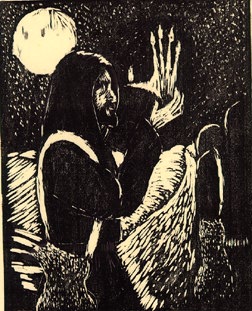
The Hand of Glory
Description: A perfectly preserved human hand covered
with rune-like tattoos. Each finger may be lit like a candle.
Est. Creation: 13th century.
Powers: When the Hand is lit, it illuminates an area about
5 meters in diameter. Any undead or demon creature that attempts
to enter that sphere will take great damage (7D) and be thrown back with
a strength of 9D. Legend has it that if the proper words are incanted,
the Hand can turn all true souls within its sphere of light invisible to
undead eyes. The Hand likely has other powers that have not been
fully discovered. The candle will remain lit for about 10 minutes
before blowing out and cannot be relit until the following day.
History: There are many scattered reports of a "Hand of
Glory" from medieval Europe. Some say it is actually the right hand of
Saint Paul, while others describe it as a child's hand, pure and soft.
There is also a legend of a "Left" Hand of Glory (or "Shame"), that actually
attracts deadites and grants some infernal powers.
[Image to right: A medieval monk using the Hand
of Glory while traveling at night. Image found at http://homepage.mac.com/gwohlken/PhotoAlbum.html]